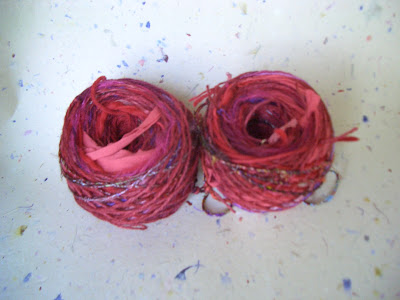
Ok, I'm ready to face the fact that I can sit for long periods of time and do very idiotic tasks when it comes to yarn. But I can be patient for the particular results that I want.
Yesterday I spent hours untangling a "skein" of railroad yarn. It was a skein once, at any rate. If the colors were not unsurpassed, I wouldn't bother. But this yarn is going to make something fabulous.
This stash in the photograph above is an instance of such persistence [or some capacity for absolute drudge work]. I have about 20 types of red yarn, so I have eyeballed lengths of about a yard then cut and tied them together to compose these balls. These are two of about six or so that it will take to make a stunning red ruana. The basic yarn that will bring everything together is a beautiful cherry red hemp and wool blend. I put a length of that between just about all the other colors. I don't do any color combination consistently so that it will be an entirely unique fabric. All the other colors make a great blend of novelty yarns and other sort of plain red yarns. Combining the yarn does take some thought. I want specific results in the blend, with a specific kind of fabric as the end result. So the way the yarns follow one another along the strand is important. The fabric is not completely predictable, but it is not a complete surprise either. I make sure that there is a certain evenness to the texture, so that there are not lumpy places or there are not big patches of one color. I tried to keep the range of weights fairly close, but I'm not afraid to put a couple fat ones and a couple skinny ones in the mix. I am very careful not to make big patches of the fat ones or skinny ones, but I keep the textures dispersed throughout the fabric. Sometimes this involves a lot of testing to see the effects of the combinations. This is a different technique than changing the yarn every row and putting the knots at the end of each row
This technique involves putting balls of various yarns out on a table and sitting with a pair of scissors beside a ball winder. Each length of yarn is pulled out of its ball, then cut and tied to the previous length, leaving a tail in the knot long enough so that it can be woven into the fabric. I leave about three cm., or about 1.75 in. I use a very sharp pair of scissors, because cutting hundreds of lengths of yarn with a dull scissors is a big drag. I also usually have a crochet hook or other device to help draw the yarn ends into the knot. It saves time. As the strand grows in length and starts to tangle, I wind it up onto the ball winder.
I'm using linen or woven stitch as it is variously called, for the fabric so that the colors will be blended across the rows.
No comments:
Post a Comment